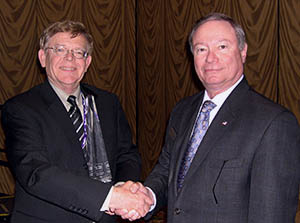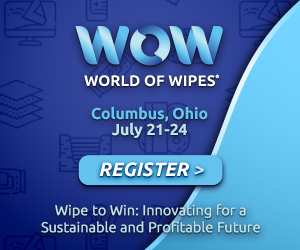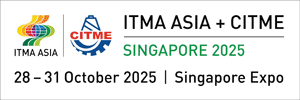David Newkirk (Industry)
Lifetime Technical Achievement Award
2008
Fiberweb
 Fiberweb would like to nominate David Newkirk for INDA’s Lifetime Technical Achievement Award. As a 30+ year technical innovator and inventor, David has contributed his time, energy and knowledge to furthering the growth of the nonwovens industry and the companies where he has been employed.
Fiberweb would like to nominate David Newkirk for INDA’s Lifetime Technical Achievement Award. As a 30+ year technical innovator and inventor, David has contributed his time, energy and knowledge to furthering the growth of the nonwovens industry and the companies where he has been employed.
He has long been a strong advocate of using nonwoven fabrics to overcome strength, elastic, extensible, barrier, softness, absorption and other performance obstacles in order to manufacture substrates that meet the needs of our customers and the consumer. His many patents demonstrate his range of creativity and his ability to extend the traditional boundaries of nonwoven fabrics to new levels of performance. Many of his individual and collaborative contributions are utilized in today’s disposable and durable items yet many may not recognize the years of development necessary to bring them to this point.
While David is probably best recognized for his recent work on extensible components which provide for better fitting baby diapers, he has also supported Fiberweb’s medical and industrial nonwoven applications, most notably the geotextile market. His skill and talent to visualize possibilities, understand the fundamentals, identify viable alternatives and deliver results have served the industry with better products.
David’s work is more aligned with actionable technical development than with theoretical solutions so his approaches are often both practical and factory-friendly. This promotes harmony between the development and commercialization process and has led to many of his product ideas being implemented. His knowledge of nonwoven processes and downstream applications make him an excellent sounding board for new ideas and a valued member of the Fiberweb technical staff.
We are grateful for the opportunity to nominate David and hope you find his lifetime contributions worthy of serious consideration.
Education:
B.S. Chemistry – Seattle-Pacific College, Seattle, Washington
Ph. D. Organic Chemistry – Oregon State University, Corvallis, Oregon
Post Doctorate Work – Kansas State University, Manhattan, Kansas
INDA Activities / Industry Activities:
- Index, IDEA, Visions, and other conferences – Participated as both attendee, exhibitor and presenter
- Served on ASTM technical committees for geotextile applications
- Participated in customer-specific trade shows
Publications / Presentations:
- Collins, T.G. and Newkirk, D.D., “The Use of Geotextile Fabrics in Pond Construction Beneath an Impermeable Membrane (Geomembrane)”, 2nd
International Conference on Geotextiles, Las Vegas Nevada, 1982. - Newkirk, D.D., “Compression Creep of Geotextiles Used as Protective Geomembrane Underlines”, International Conference on Geomembranes, Denver, CO, 1984.
- Newkirk, D.D., “Tests Prove Geotextiles Offer Long-Term Geomembrane Protection”, Geotechnical Fabrics Report, Summer 1984.
Patents:
David is inventor or co-inventor on the following patents as well as another 25 associated with chemistries which were issued prior to these.
|
Publication Date |
Publication Number |
Abstract |
|---|---|---|
|
11/28/1989 |
US4883707 |
Disclosed are high loft nonwoven fabric composites, suitable for use as coverstock in absorbent personal care articles, that are composed of at least two carded webs of bicomponent thermoplastic resin fibers, wherein the fibers making up at least one web are at least in part flat-crimped bicomponent fibers. Also disclosed is a method of making such laminates by a process that involves thru-air bonding. |
|
9/1/1992 |
US5143779 |
Disclosed is a process for making bulky nonwoven fabric suitable for use in diaper constructions that comprises the steps of (a) forming a web of one or more layers comprised at least in part of thermoplastic bicomponent fibers, (b) bonding said web by means of a thru-air system, (c) compressing–either in a nip or by winding–the resulting bonded web to increase its density, (d) transporting and/or otherwise manipulating the compressed web, and (e) subsequently transforming said compressed web, by means of exposure to heat, into the low density bulky nonwoven fabric. The bulky nonwoven fabrics are particularly useful as diaper coverstock and as diaper spacer fabrics. |
|
3/30/1993 |
US5198057 |
Disclosed is a process for making bulky nonwoven fabric suitable for use in diaper constructions that comprises the steps of (a) forming a web of one or more layers comprised at least in part of thermoplastic bicomponent fibers, (b) bonding said web by means of a thru-air system, (c) compressing–either in a nip or by winding–the resulting bonded web to increase its density, (d) transporting and/or otherwise manipulating the compressed web, and (e) subsequently transforming said compressed web, by means of exposure to heat, into the low density bulky nonwoven fabric. The bulky nonwoven fabrics are particularly useful as diaper coverstock and as diaper spacer fabrics. |
|
12/28/1993 |
US5273596 |
A multi-layer, nonwoven fabric useful as an absorbent article top sheet, which is formed of a continuous first layer, comprising hydrophobic thermoplastic fibers, bonded to a second layer, comprising a blend of hydrophobic thermoplastic fibers and natural hydrophilic fibers. |
|
12/6/1994 |
US5369858 |
A nonwoven fabric comprising at least one layer of textile fibers or net of polymeric filaments and at least one web of melt blown microfibers, bonded together by hydroentangling. The nonwoven fabric may be apertured by hydroentangling or may have areas of higher density and areas of lower density. The fabric has a favorable combination of softness, dryness, tensile strength and hand. Several processes are provided for producing the nonwoven fabric of the invention. |
|
11/28/1995 |
US5470639 |
A spunbonded elastic nonwoven fabric comprises a web of bonded thermoplastic filaments of a thermoplastic elastomer. The spunbonded fabrics of the invention are prepared in a slot draw spunbonding process operated at a rate of less than about 2000 meters per minute. The elastic fabric is used in absorbent products, such as disposable diapers, adult incontinence pads, sanitary napkins and the like, and as coverstock for absorbent personal care products. |
|
8/6/1996 |
US5543206 |
The invention is directed to composite nonwoven fabrics and processes for producing the same. The fabric includes a layer of inelastic continuous or staple fibers formed from a blend of polyethylene and polypropylene laminated to an extensible web, such as a polyolefin film. Preferably, the composition of the fibers ranges between 5 to 50 percent by weight of polypropylene with the balance made up of polyethylene. The nonelastic fibers are capable of being highly elongated upon mechanical stretching without adversely impacting fiber tie down. Accordingly, a smooth, strong, coherent fabric is obtained, which is especially well suited for incorporation into disposable absorbent articles such as diapers, training pants, incontinence briefs and feminine hygiene products. |
|
9/8/1998 |
US5804286 |
PCT No. PCT/US95/15257 Sec. 371 Date Aug. 27, 1996 Sec. 102(e) Date Aug. 27, 1996 PCT Filed Nov. 22, 1995 PCT Pub. No. WO96/16216 PCT Pub. Date May 30, 1996A fabric comprising at least two layers wherein at least one layer is an extensible, bonded non-woven composed of a fiber comprising multiple different polymers such as a fiber comprising isotactic polypropylene, polyethylene and a block or grafted polyolefin copolymer or terpolymer which is at least partially miscible with said polypropylene and polyethylene. |
|
7/13/1999 |
US5921973 |
The invention is directed to composite elastic nonwoven fabrics and processes for producing the same. The fabric includes a layer of inelastic continuous or staple fibers formed from a blend of polyethylene and polypropylene laminated to an elastic layer. Preferably, the composition of the fibers ranges between 5 to 50 percent by weight of polypropylene with the balance made up of polyethylene. The nonelastic fibers are capable of being highly elongated upon mechanical stretching without adversely impacting fiber tie down. Accordingly, a smooth, strong, coherent fabric is obtained, which is especially well suited for incorporation into disposable absorbent articles such as diapers, training pants, incontinence briefs and feminine hygiene products. |
|
12/7/1999 |
US5997989 |
A spunbonded elastic nonwoven fabric comprises a web of bonded thermoplastic filaments of a thermoplastic elastomer. The spunbonded fabrics of the invention are prepared in a slot draw spunbonding process operated at a rate of less than about 2000 meters per minute. The elastic fabric is used in absorbent products, such as disposable diapers, adult incontinence pads, sanitary napkins and the like, and as coverstock for absorbent personal care products. |
|
3/27/2001 |
US6207602 |
Nonwoven fabrics and fabric laminates are formed from continuous filaments or staple fibers of a select blend of specific grades of polyethylene and polypropylene which give improved fabric performance not heretofore recognized or described, such as high abrasion resistance, good tensile properties, excellent softness and the like. Furthermore, these blends have excellent melt spinning and processing properties which permit efficiently producing nonwoven fabrics at high productivity levels. The polymers are present as a lower-melting dominant continuous phase and at least one higher-melting noncontinuous phase dispersed therein. The lower-melting continuous phase forms at least 70 percent by weight of the fiber and comprises a linear low density polyethylene polymer of a melt index of greater than 10 and a density of less than 0.945 g/cc. At least one higher-melting noncontinuous phase comprises a polypropylene polymer with melt flow rate of greater than 20 g/10 min. |
|
7/9/2002 |
US6417121 |
The present invention provides multicomponent fibers arranged in structured domains. At least one of the polymer components is formed of a multipolymer blend. The present invention also provides nonwoven fabrics formed of the multicomponent fibers, the fabrics having a superior combination of extensibility, tensile properties and abrasion resistance. A second layer can be laminated to this coherent extensible nonwoven web. |
|
7/9/2002 |
US6417122 |
The present invention provides multicomponent fibers arranged in structured domains. At least one of the polymer components is formed of a multipolymer blend. The present invention also provides nonwoven fabrics formed of the multicomponent fibers, the fabrics having a superior combination of extensibility, tensile properties and abrasion resistance. A second layer can be laminated to this coherent extensible nonwoven web. |
|
7/16/2002 |
US6420285 |
The present invention provides multicomponent fibers arranged in structured domains. At least one of the polymer components is formed of a multipolymer blend. The present invention also provides nonwoven fabrics formed of the multicomponent fibers, the fabrics having a superior combination of extensibility, tensile properties and abrasion resistance. A second layer can be laminated to this coherent extensible nonwoven web. |
|
9/10/2002 |
US6448194 |
Nonwoven fabrics and fabric laminates are formed from continuous filaments or staple fibers of a select blend of specific grades of polyethylene and polypropylene which give improved fabric performance not heretofore recognized or described, such as high abrasion resistance, good tensile properties, excellent softness and the like. Furthermore, these blends have excellent melt spinning and processing properties which permit efficiently producing nonwoven fabrics at high productivity levels. The polymers are present as a lower-melting dominant continuous phase and at least one higher-melting noncontinuous phase dispersed therein The lower-melting continuous phase forms at least 70 percent by weight of the fiber and comprises a linear low density polyethylene polymer of a melt index of greater than 10 and a density of less than 0.945 g/cc. At least one higher-melting noncontinuous phase comprises a polypropylene polymer with melt flow rate of greater than 20 g/10 min. |
|
10/15/2002 |
US6465378 |
Nonwoven fabrics and fabric laminates are formed from continuous filaments or staple fibers of a select blend of specific grades of polyethylene and polypropylene which give improved fabric performance not heretofore recognized or described, such as high abrasion resistance, good tensile properties, excellent softness and the like. Furthermore, these blends have excellent melt spinning and processing properties which permit efficiently producing nonwoven fabrics at high productivity levels. The polymers are present as a lower-melting dominant continuous phase and at least one higher-melting noncontinuous phase dispersed therein. The lower-melting continuous phase forms at least 70 percent by weight of the fiber and comprises a linear low density polyethylene polymer of a melt index of greater than 10 and a density of less than 0.945 g/cc. At least one higher-melting noncontinuous phase comprises a polypropylene polymer with melt flow rate of greater than 20 g/10 min. |
|
10/22/2002 |
US6468931 |
A multilayer thermally bonded nonwoven fabric which is particularly useful as a liner in an absorbent product is described. The fabric includes at least two prebonded nonwoven webs having a multiplicity of intralaminar bonds bonding the fibers of the prebonded nonwoven webs together. The prebonded webs are secured together to form the fabric of the invention by a plurality of interlaminar thermal bonds formed of discrete areas of compressed and fused fibers of the prebonded webs. |
|
1/14/2003 |
US6506698 |
The present invention provides a composite nonwoven fabric with a superior combination of extensibility, tensile properties and abrasion resistance. The composite nonwoven fabric (10) comprises at least one layer containing multipolymer fibers, with a plurality of bonds bonding the fibers together to form a coherent extensible nonwoven web (11). This coherent extensible nonwoven web (11) has a Taber surface abrasion value (rubber wheel) of greater than 10 cycles and an elongation at peak load in at least one of the machine direction or the cross-machine direction of at least 70%. A second extensible layer (12) is laminated to this coherent extensible nonwoven web (11). |
|
2/11/2003 |
US6516472 |
Nonwoven fabrics and fabric laminates are formed from continuous filaments or staple fibers of a select blend of specific grades of polyethylene and polypropylene which give improved fabric performance not heretofore recognized or described, such as high abrasion resistance, good tensile properties, excellent softness and the like. Furthermore, these blends have excellent melt spinning and processing properties which permit efficiently producing nonwoven fabrics at high productivity levels. The polymers are present as a lower-melting dominant continuous phase and at least one higher-melting noncontinuous phase dispersed therein. The lower-melting continuous phase forms at least 70 percent by weight of the fiber and comprises a linear low density polyethylene polymer of a melt index of greater than 10 and a density of less than 0.945 g/cc. At least one higher-melting noncontinuous phase comprises a polypropylene polymer with melt flow rate of greater than 20 g/10 min. |
|
10/14/2003 |
US6632504 |
A nonwoven web is provided which can be readily converted to an apertured web by stretching. In its initial non-apertured state, the web comprises a plurality of multicomponent fibers comprising at least two thermoplastic polymer components arranged in at least first and second separate continuous structured domains. The polymer component of the first domain comprises polyethylene. Prior to stretch aperturing, the web has a peak elongation of at least 100 percent and is characterized by having a plurality of discrete, spaced-apart, frangible bond sites of polymer bonding the fibers to form a coherent extensible nonwoven web. The frangible bond sites are structured and arranged to readily rupture when subjected to tensile stress to form discrete, spaced-apart apertures in the nonwoven fabric. The web has a total energy absorption in at least one of the machine direction or the cross-machine direction of at least 50 gcm/cm2. |
Thank you again for your consideration.



